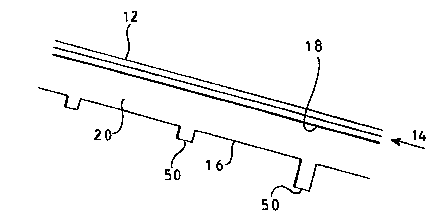Une partie des informations de ce site Web a été fournie par des sources externes. Le gouvernement du Canada n'assume aucune responsabilité concernant la précision, l'actualité ou la fiabilité des informations fournies par les sources externes. Les utilisateurs qui désirent employer cette information devraient consulter directement la source des informations. Le contenu fourni par les sources externes n'est pas assujetti aux exigences sur les langues officielles, la protection des renseignements personnels et l'accessibilité.
L'apparition de différences dans le texte et l'image des Revendications et de l'Abrégé dépend du moment auquel le document est publié. Les textes des Revendications et de l'Abrégé sont affichés :
| (12) Demande de brevet: | (11) CA 2332602 |
|---|---|
| (54) Titre français: | SYSTEME DE REGULATION D'ECOULEMENT D'EAU |
| (54) Titre anglais: | WATER FLOW CONTROL SYSTEM |
| Statut: | Réputée abandonnée et au-delà du délai pour le rétablissement - en attente de la réponse à l’avis de communication rejetée |
| (51) Classification internationale des brevets (CIB): |
|
|---|---|
| (72) Inventeurs : |
|
| (73) Titulaires : |
|
| (71) Demandeurs : |
|
| (74) Agent: | BERESKIN & PARR LLP/S.E.N.C.R.L.,S.R.L. |
| (74) Co-agent: | |
| (45) Délivré: | |
| (86) Date de dépôt PCT: | 1999-05-17 |
| (87) Mise à la disponibilité du public: | 1999-11-25 |
| Licence disponible: | S.O. |
| Cédé au domaine public: | S.O. |
| (25) Langue des documents déposés: | Anglais |
| Traité de coopération en matière de brevets (PCT): | Oui |
|---|---|
| (86) Numéro de la demande PCT: | PCT/GB1999/001552 |
| (87) Numéro de publication internationale PCT: | GB1999001552 |
| (85) Entrée nationale: | 2000-11-16 |
| (30) Données de priorité de la demande: | ||||||
|---|---|---|---|---|---|---|
|
L'invention concerne un système de pavage permettant de réguler le drainage et/ou l'écoulement d'eau sur une pente, qui comporte une couche perméable constituant une surface (12) supérieure, au moins une couche de substrat de support située sous celle-ci et qui est perméable aux liquides, une couche (16) de confinement contenant ladite couche (20) de substrat et servant à limiter un ruissellement d'eau provenant de ladite couche de substrat de support dans le sol environnant; et un moyen (50, 60) de déversoir servant à réguler l'écoulement d'eau sur la pente.
A paving system for controlling drainage and/or flow of water on a slope
comprises a permeable layer providing an upper surface (12), at least one
supporting substrate layer thereunder which is permeable to liquid, a
containment layer (16) containing said substrate layer (20) for restricting
release of water from said supporting substrate layer into surrounding ground;
and weir means (50, 60) for controlling the flow of water down the slope.
Note : Les revendications sont présentées dans la langue officielle dans laquelle elles ont été soumises.
Note : Les descriptions sont présentées dans la langue officielle dans laquelle elles ont été soumises.

2024-08-01 : Dans le cadre de la transition vers les Brevets de nouvelle génération (BNG), la base de données sur les brevets canadiens (BDBC) contient désormais un Historique d'événement plus détaillé, qui reproduit le Journal des événements de notre nouvelle solution interne.
Veuillez noter que les événements débutant par « Inactive : » se réfèrent à des événements qui ne sont plus utilisés dans notre nouvelle solution interne.
Pour une meilleure compréhension de l'état de la demande ou brevet qui figure sur cette page, la rubrique Mise en garde , et les descriptions de Brevet , Historique d'événement , Taxes périodiques et Historique des paiements devraient être consultées.
| Description | Date |
|---|---|
| Inactive : CIB de MCD | 2006-03-12 |
| Inactive : CIB de MCD | 2006-03-12 |
| Demande non rétablie avant l'échéance | 2003-05-20 |
| Le délai pour l'annulation est expiré | 2003-05-20 |
| Réputée abandonnée - omission de répondre à un avis sur les taxes pour le maintien en état | 2002-05-17 |
| Lettre envoyée | 2001-05-16 |
| Inactive : Transfert individuel | 2001-04-06 |
| Inactive : Page couverture publiée | 2001-03-19 |
| Inactive : CIB en 1re position | 2001-03-11 |
| Inactive : Lettre de courtoisie - Preuve | 2001-03-06 |
| Inactive : Notice - Entrée phase nat. - Pas de RE | 2001-02-28 |
| Demande reçue - PCT | 2001-02-26 |
| Demande publiée (accessible au public) | 1999-11-25 |
| Date d'abandonnement | Raison | Date de rétablissement |
|---|---|---|
| 2002-05-17 |
Le dernier paiement a été reçu le 2000-11-16
Avis : Si le paiement en totalité n'a pas été reçu au plus tard à la date indiquée, une taxe supplémentaire peut être imposée, soit une des taxes suivantes :
Les taxes sur les brevets sont ajustées au 1er janvier de chaque année. Les montants ci-dessus sont les montants actuels s'ils sont reçus au plus tard le 31 décembre de l'année en cours.
Veuillez vous référer à la page web des
taxes sur les brevets
de l'OPIC pour voir tous les montants actuels des taxes.
| Type de taxes | Anniversaire | Échéance | Date payée |
|---|---|---|---|
| Taxe nationale de base - petite | 2000-11-16 | ||
| TM (demande, 2e anniv.) - petite | 02 | 2001-05-17 | 2000-11-16 |
| Enregistrement d'un document | 2001-04-06 |
Les titulaires actuels et antérieures au dossier sont affichés en ordre alphabétique.
| Titulaires actuels au dossier |
|---|
| COVENTRY UNIVERSITY |
| Titulaires antérieures au dossier |
|---|
| CHRISTOPHER JOHN PRATT |